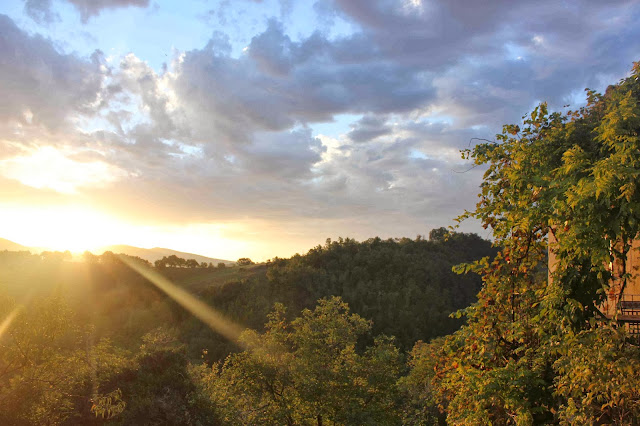After returning from Croatia we all settled in for a two day art project to represent completion of our art course, Science and the Aesthetic. Sandro's wife, Paula Metallo (born and raised in Syracuse), did a great job inspiring all of these scientists who had little confidence with expressing themselves through art. The funny thing was that we discovered that everyone actually had experience in some totally different art concentration, which made for a very diverse art show. The show also had a theme of "Give and Take" and each piece was expected to represent something relating both to science and to the concept of give and take. Once set up in Coldigioco's little gallery space the show made a gorgeous composition as a whole and was a great place for getting to know our guests that night, a band of American folk musicians visiting one of the geologists staying in town at the time.
Devon depicted Mother Earth being exploited by the consumer mass.
Bryn used a flip book to depict a farm being fertilized while the resulting runoff kills fish in the neighboring body of water.
Colin used charcoal to create a shape reminiscent of a simplified geologic cross-section of a subduction fault.
Alyssa used pencil to draw an incredibly detailed beach being eroded by waves of the ocean: "The Great Giver and Taker."
Alison's four colored pencil drawings show how natural events like the passage of the seasons and the breakup of Pangaea depict the passage of time, although they do so at different scales of time.
Taylor created a landscape using trash found on the side of the road and then photographed the result.
Catherine photographed, drew three times, and sampled a leaf from the same tree a short walk down the road of Coldigioco.
Robby used white limestone and red chert to construct the form of a yin yang on the floor.
Sam used watercolors to paint a picture attempting to synthesize a photograph of an amazing glacial valley in Tuscany and a dream he had a few nights after we had been there.
Alex used wire, paper mache, torn newspaper, and Italian and Croatian currency to represent how a profiteer might see the environment in order to justify exploitation of natural resources.
Catie used oil pastels to draw an amazing sight we saw with clouds being blown across a mountaintop in the Dolomites.
Hannah made a traditional embroidered ball made by mothers, daughters, and friends in Japanese culture.
Travis made a coil pot out of locally resourced clay and little sample bags of powdered sediment from previous projects taken throughout our travels. He then drew pictures to demonstrate the three staples of Mediterranean agriculture: wheat,...
...grapes,...
...and olives.
I painted a mandala superimposing various natural cycles working in competition and cooperation to maintain the balance that makes the world a livable place. The square meter canvas sat on the floor of the gallery.




















































